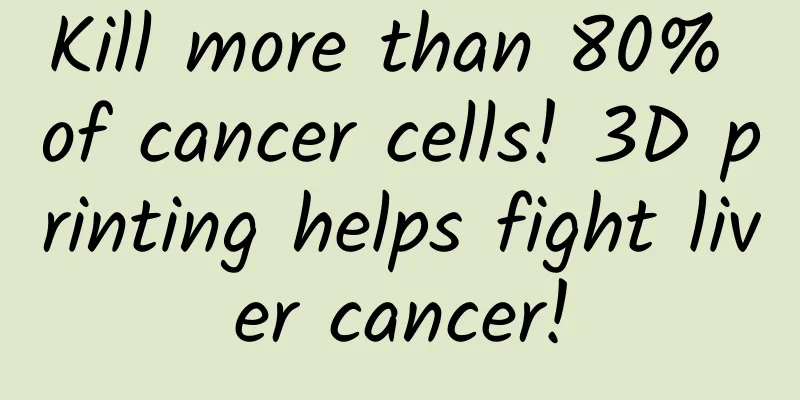Kill more than 80% of cancer cells! 3D printing helps fight liver cancer!

|
At present, primary liver cancer is the fourth most common malignant tumor and the second leading cause of death from cancer in China, which seriously threatens people's lives and health. It hangs over individuals and families like a dark cloud, bringing them a heavy physical and mental burden. In the past, the means of fighting liver cancer were mainly surgical resection for patients with liver cancer who were not in the advanced stage of the disease. However, residual micro-tumor cells may still cause disease recurrence. Previous studies have shown that up to 46% of patients have residual cells detected at the edge of the liver after resection. Sadly, the prognosis of liver cancer faces great challenges and the survival rate is very low! Therefore, doctors and researchers are tirelessly seeking a good way to conquer cancer. In addition to using adjuvant chemotherapy to improve the survival rate of patients with liver cancer, the local drug delivery system (DDS) combined with 3D printing technology is like a rising star, bringing the dawn of life and hope to patients! Recently, Professor Sanjay Garg's team at the University of Adelaide, Australia, published a research paper in the International Journal of Pharmaceutics titled Printing a cure: A tailored solution for localized drug delivery in liver cancer treatment. This study proved for the first time in the world that a 3D printed film made of gel loaded with tailored doses of anticancer drugs 5-fluorouracil (5FU) and cisplatin (Cis, cisplatin) can effectively kill more than 80% of liver cancer cells, significantly reduce the recurrence rate, and greatly reduce the systemic side effects of traditional chemotherapy. This breakthrough research progress not only brings good news to liver cancer patients, but also provides new technical support for the treatment of various cancers such as ovarian cancer and head and neck cancer! ****Source: International Journal of Pharmaceutics Research content and results Previous studies have shown that the combination of 5-fluorouracil (5FU) and cisplatin (Cis) is highly effective in treating liver cancer, and the combination has been co-formulated in the form of a hydrogel for intraoperative chemotherapy of gastric cancer. Although the use of 5-fluorouracil (5FU) and cisplatin (Cis) has improved the anti-cancer effect in several cancer types, a consistent protocol for dosage and administration has not been established, and each treatment method involves different dosage and administration methods. Currently, there are several methods for making gel films in the medical field, including solvent casting, electrospinning, and hot melt extrusion. However, due to the heterogeneity of cancer, constructing a new method that is different from a "one-size-fits-all" approach is extremely necessary for complex anti-cancer treatment. In recent years, the adoption of 3D printing technology has achieved substantial breakthroughs in the field of cancer prevention and treatment, which can provide personalized and customized treatment plans to meet the special needs of individual patients. To solve the above problems, researchers have developed a postoperative chemotherapy loading membrane structure-3D printed membrane, which is made of gel loaded with tailored doses of anti-cancer drugs 5-fluorouracil (5FU) and cisplatin (Cis), which can be placed at the exact surgical site where the cancer is removed, so as to target the drug to the affected lesion area, thereby accurately attacking possible residual cancer cells, while also effectively limiting the adverse side effects of traditional chemotherapy. Source: International Journal of Pharmaceutics In this study, the team used advanced 3D printing technology, including customizing film geometry, adjusting drug release profiles, and adding or removing active ingredients. Different structures of 3D printed drugs have different sustained-release time curves. The filling pattern of each layer of film is different, with the first and second layers being grid-shaped and honeycomb-shaped, respectively. The research team found that different filling patterns can provide the best design during printing, stably maintaining the structure of the film, and drug release can be adjusted by trying different filling ratios. After testing, the pressure of the first layer of the film was 35-55 kPa, and the pressure of the second layer was 40-60 kPa. Such on-demand customization of drug release curves and membrane structures can effectively ensure accurate drug delivery, reduce the burden on the blood system, reduce the serious side effects of high-dose drugs on patients, and provide each patient with a personalized treatment plan. Source: International Journal of Pharmaceutics Professor Garg pointed out that this tailored medication strategy is the key to improving the efficiency of cancer treatment. Given the diversity of cancer, traditional standardized treatment is no longer applicable. This 3D printed film demonstrated the ability to control drug release for up to 23 days, which not only ensures sustained treatment effects, but also its biodegradable properties avoid the need for secondary surgery, making the treatment process more humane. In addition, the study also optimized the greenness of the 3D printing process, evaluated and modified it according to the score of the indicators, making it more environmentally friendly! Research Prospects 3D printing technology, also known as "additive manufacturing" or "rapid prototyping" technology, is a process that uses a print head, nozzle or other printing technology to build up materials and manufacture parts or objects based on three-dimensional model data. Currently, 3D printing technology is developing rapidly and is a standout in the field of biomedical applications, attracting more and more attention. On February 1, 2024, Zhang Suchun's team at the University of Wisconsin-Madison published a research paper in the journal Cell Stem Cell titled 3D bioprinting of human neural tissues with functional connectivity. The study used horizontal printing to place brain cells (neurons differentiated from iPSCs) in a softer "bio-ink" gel, and developed the first 3D printed functional human brain tissue, in which neurons and glial cells form functional connections within and between tissue layers, can grow and function like typical human brain tissue, and organically achieve control over cell types and arrangements, which is not available in brain organoids, providing new technical support for studying the brain and treating a wide range of nervous system and neurodevelopmental disorders (such as Alzheimer's disease and Parkinson's disease)! Source: Cell Stem Cell Let us wait and see the emerging medical darlings like 3D printing technology. May doctors and scientists conquer diseases as soon as possible and restore health and safety to mankind! References: [1] Souha H Youssef, Raja Ganesan, Marzieh Amirmostofian, et al. Printing a cure: A tailored solution for localized drug delivery in liver cancer treatment, International Journal of Pharmaceutics (2024). DOI: 10.1016/j.ijpharm.2024.123790 [2] Yan Y, Li |
Recommend
One hospital performed 67 lung lavages in one day! Do you need to perform lung lavages if you have mycoplasma pneumonia? Expert answers
Do you need a lung cleanse? Mycoplasma pneumoniae...
How long does it take to induce abortion with Chinese medicine?
Important reminder: Chinese herbal abortion is al...
What medicine is better for women to delay aging?
When people reach a certain age, they will find t...
How to wash nail polish
Love of beauty is the nature of modern people. Be...
Where is the hymen located?
The hymen is broken, also known as the urethral v...
Getui Big Data: 2019 Q1 Domestic Android Smartphone Report
Getui Big Data (stock code: 300766) released the ...
The period has never been bleeding, especially little
Under normal circumstances, women have their peri...
Next stop is happiness He Fanxing drunken BGM what is called Next stop is happiness drunken background music
After the TV series "The Next Stop Is Happin...
Do I need to fast for Down syndrome screening?
Regular Down syndrome screening can effectively h...
52-year-old woman has bright red menstruation again after six months of menopause
Women will go through menopause at a certain age....
What to do if you have a cough during early pregnancy
It is inevitable that pregnant women will suffer ...
What are the treatments for folliculitis in women?
In life, many people are suffering from folliculi...
What items should be checked for infertility?
Women often experience infertility. Once they enc...









